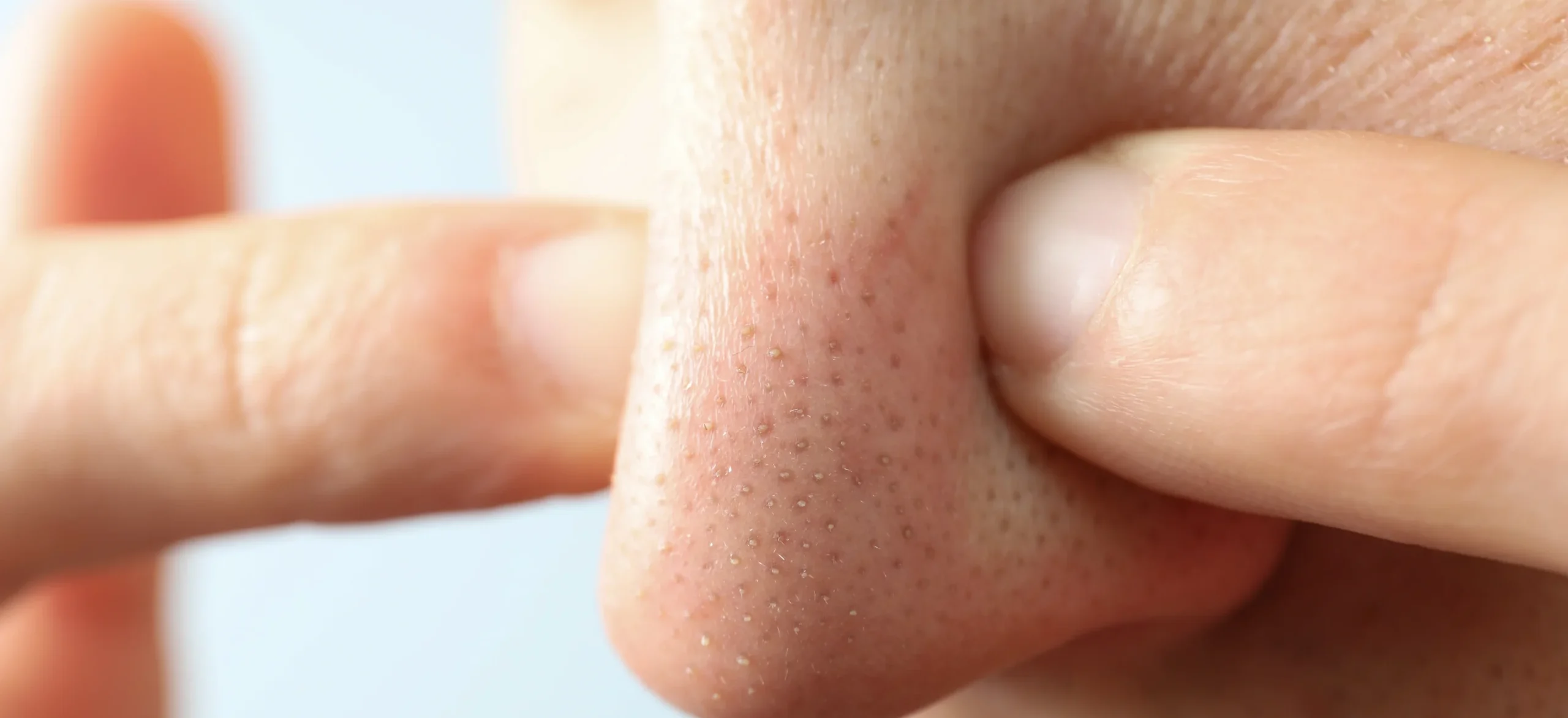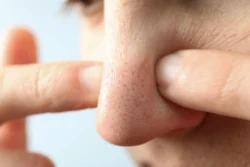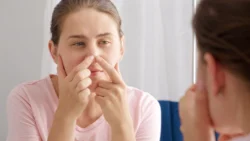
How to Get Rid of Blackheads on Nose and Ears
Blackheads are one of the most common skin concerns, and they have a special way of showing up in the most visible places. The nose is a favorite spot for blackheads, and surprisingly, the outer ears can be another area where they quietly build up. Many people try to squeeze or scrub them away, but that often only provides short-term results or makes the skin worse.
The good news is that blackheads can be treated and controlled. With the right approach, you can reduce their appearance and keep them from returning. This guide will explain everything you need to know in clear, simple language. You will learn what blackheads are, why they appear on the nose and ears, and exactly how to remove them safely and effectively.
Understanding What Blackheads Are
What Blackheads Actually Mean
Blackheads are a type of acne, also called open comedones. A pore becomes clogged with oil, dead skin cells, and sometimes bits of dirt or product buildup. Because the top of the pore is open to the air, the material inside turns dark when it oxidizes. This is why blackheads are black or dark gray in color.
The dark color does not mean your skin is dirty. It is simply the result of oxygen reacting with oil and dead cells in the pore. Many people believe they can scrub blackheads away like dirt, but that does not work. Blackheads are trapped inside the pore, not sitting on top of the skin’s surface.
Why Blackheads Are So Common on the Nose and Ears
The skin on the nose and around the ears has more sebaceous glands than many other areas of the face. Sebaceous glands produce sebum, which is the skin’s natural oil. This oil is important for keeping the skin hydrated and flexible, but too much of it can clog pores.
The nose is especially prone to blackheads because of its shape and the number of oil glands in that area. The ears, especially the outer rim, folds, and the area behind the ear, can also trap oil, sweat, sunscreen, and hair products. Over time, these things build up, and blackheads form quietly.
Blackheads Versus Other Skin Bumps
Not all small bumps on the face or ear are blackheads. Many people confuse other skin issues with blackheads, which can lead to using the wrong treatments. Here is how to tell them apart:
- Blackheads are dark, flat, or slightly raised. They are not usually painful. The black color comes from oxidation.
- Whiteheads are closed comedones. They look like tiny white bumps and are covered with a thin layer of skin.
- Pimples are inflamed, often red, swollen, and sometimes painful.
- Sebaceous filaments are often mistaken for blackheads, especially on the nose. These are normal structures in the pores that help carry oil to the surface. They appear as tiny, light gray or yellow dots, often in a regular pattern. You cannot get rid of them permanently because they are part of the skin’s natural system.
Knowing the difference between these bumps helps you choose the right method to treat them. True blackheads can be managed with proper skincare and gentle removal.
Why Blackheads Keep Coming Back
Many people notice that even after squeezing or removing blackheads, they seem to return a week or two later. This happens for a few reasons:
- Temporary removal does not address the cause. Squeezing can remove the plug inside the pore, but if the pore is still producing excess oil and dead skin cells, another plug will form.
- Over-scrubbing can irritate the skin. When the skin barrier is irritated, the skin may produce even more oil, which increases the chance of clogged pores.
- Inconsistent routines. Blackhead control works best with a steady, gentle skincare routine over time, not one-time fixes.
- Environmental factors. Sweat, heat, pollution, makeup, and hair products can quickly clog the nose and ear area if not cleaned properly.
The secret is not to attack blackheads harshly but to care for your skin consistently in a way that prevents them from forming in the first place.
Ingredients That Actually Work for Blackheads
Not every product on the shelf will help with blackheads. Some ingredients are proven to help clear clogged pores and prevent new ones from forming. These ingredients work best when used correctly and consistently.
Salicylic Acid
Salicylic acid is one of the best ingredients for blackheads. It is a beta hydroxy acid that dissolves oil, unlike some other exfoliants that only work on the surface. Salicylic acid can reach inside the pore, break up the clog, and help dead skin cells shed more evenly.
- Use a cleanser with 0.5 to 2 percent salicylic acid once or twice a day.
- If you prefer, you can use a leave-on toner or gel at night.
- Start slowly to see how your skin reacts. Some people only need to use it a few times a week.
Retinoids
Retinoids speed up cell turnover and help keep pores clear. Over the counter adapalene gel or retinol serums are gentle options that can make a big difference over time. They work by preventing dead cells from sticking together inside the pore.
- Start using a retinoid two or three nights a week.
- Use a pea-sized amount for the whole face, including the nose area.
- If your skin feels dry at first, apply a moisturizer afterward.
- Over time, retinoids help pores look smoother and clearer.
Benzoyl Peroxide
Benzoyl peroxide is great if blackheads appear along with pimples. It kills acne-causing bacteria and can help reduce inflammation. It is best used as a short contact wash rather than a leave-on product for blackheads.
- Use a 2.5 to 5 percent benzoyl peroxide cleanser for 1 to 2 minutes, then rinse well.
- Do not overuse it, as it can dry out the skin.
Alpha Hydroxy Acids (AHAs)
Glycolic acid and lactic acid are gentle acids that help remove dead skin cells on the surface. This makes it easier for pores to stay open and clear. A gentle AHA product once or twice a week can smooth skin and keep blackheads from coming back.
Niacinamide
Niacinamide helps support the skin barrier and balance oil production. It is gentle and pairs well with other ingredients. A 2 to 5 percent serum works well for most people. It does not remove blackheads directly but makes your skin healthier overall.
Clay and Sulfur Masks
Clay masks (like kaolin or bentonite) can absorb surface oil, tighten the look of pores, and make blackheads easier to remove. Sulfur masks help loosen blackhead plugs and reduce excess oil.
- Use these masks once a week.
- Do not let clay masks dry out and crack, as this can irritate the skin.
- Rinse them off when they turn lighter in color.
A Gentle Step-by-Step Routine for the Nose
The nose is one of the most common spots for blackheads. Here’s a simple routine to help you clear and prevent them.
- Start with a gentle cleanse – Wash your face twice a day with a mild, non-comedogenic cleanser. Lukewarm water works best. Hot water can dry out the skin and trigger more oil production.
- Use a targeted treatment – At night, apply salicylic acid or a retinoid to the nose area. If you use both, alternate them on different nights to prevent irritation.
- Hydrate the skin – Use a lightweight, oil-free moisturizer. Healthy skin sheds cells evenly and clogs less often.
- Steam lightly if needed – A short, warm compress can help soften blackheads before using a clay mask or doing a gentle extraction. Do not steam for too long, and never use hot water.
- Apply a clay mask once a week – This helps draw oil and dirt out of the surface of pores. Rinse gently with lukewarm water.
- Avoid harsh scrubbing – Over-exfoliation will not remove blackheads faster. In fact, it can make them worse.

How to Remove a Blackhead Safely at Home
Blackhead extraction can be done at home, but it must be done gently and with clean tools to avoid irritation or scarring.
What You Need
- A clean mirror with good lighting
- Alcohol wipes or soap and water for cleaning tools
- A comedone extractor loop or cotton swabs
- Clean hands
Steps to Follow
- Wash your face and pat it dry.
- If needed, use a warm compress for one or two minutes to soften the skin.
- Disinfect the extractor loop with alcohol.
- Position the loop around the blackhead and press gently downward, then slightly to the side. The blackhead should pop out with light pressure.
- If it does not, stop. Do not force it.
- After extraction, wipe the area with a mild toner or micellar water.
- Apply a light moisturizer to calm the skin.
Do not overdo extractions. Once every week or two is enough. If a blackhead is too deep, it is safer to leave it alone or have it removed by a professional.
How to Treat and Prevent Blackheads on the Ears
Many people are surprised to find blackheads on the ears. This happens mostly around the outer rim of the ear, in the folds, and behind the ear. These areas trap oil, sweat, hair products, and dirt easily.
Daily Cleaning for the Ears
- Clean the outer ear gently with a damp cotton pad and mild cleanser.
- Use a cotton swab with a small amount of salicylic acid toner to swipe the outer folds and behind the ear.
- Never insert anything inside the ear canal. If blackheads are inside the canal, see a doctor.
- Apply a light moisturizer or a single drop of non-comedogenic oil if the area feels dry.
Weekly Deep Care
- Apply a clay mask on the outer ear for 5 minutes and rinse gently.
- Clean headphones, earbuds, and your phone regularly with alcohol wipes.
- Wash hair products off the ear area thoroughly at night.
Ears are sensitive, so be extra gentle with any extraction. If a blackhead is hard to reach or remove, it is safer to let a professional do it.
Helpful Tools for Blackhead Care
Pore Strips
Pore strips can remove the surface part of blackheads quickly. They are not a long-term solution, but they can give a smoother look for a short time. Use them at most once every two weeks and remove them slowly to avoid irritation.
Hydrocolloid Patches
Hydrocolloid patches work better on whiteheads and pimples, but they can protect areas where blackheads were extracted and prevent touching or scratching.
Silicone Scrubbers
Soft silicone pads can help distribute cleanser better and gently clean around pores. They are safer than harsh scrubs but should still be used lightly.
Cleansing Brushes
Some people like using cleansing brushes to keep their pores clean. If you use one, choose a soft brush head and use it only a few times a week. Overuse can irritate the skin.
Building a Daily Skincare Routine for Blackhead Prevention
Blackhead removal is important, but prevention is key. A simple daily routine can keep your pores cleaner, smoother, and less likely to clog.
Morning Routine
- Cleanser – Wash your face with a gentle cleanser. If you have oily skin, a salicylic acid cleanser can help.
- Treatment – If your night routine includes a retinoid, use something calming like niacinamide in the morning.
- Moisturizer – Choose an oil-free, fragrance-free moisturizer to keep your skin balanced.
- Sunscreen – Always use sunscreen during the day. Sun exposure can make pores look larger and dark marks more noticeable after extractions.
Night Routine
- Remove makeup or sunscreen – If you wear makeup or sunscreen, start with a cleansing oil or balm, then follow with your regular cleanser.
- Apply actives – Use salicylic acid or a retinoid on your nose and ear area at night. Alternate between them if your skin is sensitive.
- Moisturize – Hydration supports your skin barrier, making your skin stronger and less prone to clogging.
Weekly Add-Ons
- A clay or sulfur mask once a week
- Targeted extraction once every one or two weeks
- Changing pillowcases and towels regularly to reduce bacteria buildup
Lifestyle Habits That Support Clear Skin
Blackhead prevention goes beyond skincare products. Everyday habits also make a big difference.
- Keep anything that touches your face clean. Wipe your phone, headphones, and glasses daily. Wash hats, scarves, and masks often.
- Watch hair products. Heavy hair gels, sprays, and pomades can transfer to your ears and nose area. Try to keep them away from your skin.
- Take care of sweat. After exercising or sweating, rinse your face and ears with water or a gentle cleanser as soon as possible.
- Sleep hygiene matters. Pillowcases collect oil and dirt. Wash them at least twice a week.
- Diet and hydration. A balanced diet and good hydration support healthy skin. Foods with a lower glycemic index can help some people reduce breakouts.
- Manage stress. High stress can increase oil production in some people. Gentle movement, enough sleep, and relaxation can help.
Mistakes That Make Blackheads Worse
Many people accidentally make blackheads worse by using the wrong methods. Avoid these common mistakes:
- Scrubbing too hard. This can irritate the skin and cause micro-tears.
- Using too many active ingredients at once. Layering strong acids and retinoids every night can lead to redness and more oil production.
- Steaming for too long. Long steam sessions dry out the skin and can cause rebound oil.
- Using toothpaste or lemon on the skin. These popular “home remedies” are too harsh and can damage your skin.
- Pulling at skin daily with pore strips. Overuse of strips can cause broken capillaries and enlarged pores.
- Squeezing with fingernails. This can leave permanent marks or scars.
When to See a Dermatologist
Sometimes, at-home care is not enough. It is smart to see a professional if:
- You have deep, stubborn blackheads that do not respond to skincare.
- You see blackheads inside the ear canal.
- You have other acne problems like cysts, redness, or scarring.
- You have tried a routine for 8 to 12 weeks without results.
A dermatologist can use stronger treatments like professional extractions, chemical peels, or prescription retinoids to help clear your skin faster and more safely.

Frequently Asked Questions About Blackheads
Are blackheads a sign of dirty skin?
No. Blackheads are not caused by dirt. They happen when oil and dead skin cells oxidize in the pore.
Do blackheads make pores bigger?
Blackheads can make pores look more visible. Removing and preventing them can make pores look smaller, though you cannot actually shrink them permanently.
Can sunscreen cause blackheads?
Some heavy sunscreens can clog pores, but many non-comedogenic options are safe for oily skin. Sunscreen is essential to prevent dark spots and irritation after extractions.
How long does it take to see results?
With consistent skincare, you can see smoother skin in about 4 weeks. The best results often show after 8 to 12 weeks.
Can I get rid of sebaceous filaments completely?
No. They are part of your skin’s natural structure. You can make them less noticeable with salicylic acid, retinoids, and clay masks.
Can I use natural oils for blackheads?
Some light oils like squalane are fine, but heavier oils may clog pores. Always test new products slowly.
A Simple Seven-Day Starter Plan
Here is a practical example of how to start your blackhead care routine. You can adjust it based on how your skin reacts.
- Day 1: Morning cleanse, niacinamide, sunscreen. Night double cleanse, retinoid, moisturizer.
- Day 2: Morning cleanse, sunscreen. Night cleanse, salicylic acid toner on nose and ears, moisturizer.
- Day 3: Morning cleanse, sunscreen. Night cleanse, retinoid, moisturizer.
- Day 4: Morning cleanse, sunscreen. Night cleanse, rest or niacinamide only.
- Day 5: Morning cleanse, sunscreen. Night cleanse, salicylic acid toner, moisturizer.
- Day 6: Morning cleanse, sunscreen. Night cleanse, clay mask on nose and ears, moisturizer.
- Day 7: Morning cleanse, sunscreen. Night cleanse, retinoid, moisturizer.
This is a gentle rhythm that avoids overwhelming your skin. Stick to this routine for at least 8 weeks before making changes.
Ear Care Checklist
- Clean outer ears daily with a mild cleanser.
- Wipe headphones, earbuds, and phones often.
- Use a small amount of salicylic acid on a cotton swab around the outer ear a few times a week.
- Do not put anything inside the ear canal.
- Be gentle if you try to extract a blackhead around the ear. Stop if it does not come out easily.
Choosing the Right Products
You do not need fancy products to clear blackheads. Look for:
- Gentle, non-comedogenic cleanser
- Salicylic acid product (0.5 to 2 percent)
- Retinoid or retinol serum
- Lightweight moisturizer
- Clay mask
- Broad-spectrum sunscreen
Introduce new products one at a time and give each a week or two to see how your skin reacts.
Signs Your Routine Is Working
You will know your blackhead care routine is working when:
- Your nose and ears feel smoother to the touch.
- Black dots are less noticeable in bright light.
- Extractions, if you do them, are easier and require less pressure.
- Your skin feels calm and balanced, not irritated or dry.
- You get fewer new blackheads each week.
If after 8 to 12 weeks you do not see progress, it may be time to see a professional.
What to Do if You Irritate Your Skin
If your skin gets red, flaky, or stings, it means you may have overdone it.
- Stop all active treatments for a few days.
- Use only a gentle cleanser and a calming moisturizer.
- Once the skin feels better, reintroduce products slowly.
- Use fewer actives or space them out more.
Patience is key. Blackhead care is not about doing everything at once. It is about doing the right things consistently.
Conclusion
Blackheads on the nose and ears are common, and almost everyone deals with them at some point. The key to getting rid of them is not aggressive scrubbing or squeezing but steady, gentle care. Salicylic acid and retinoids are proven ingredients that clear and prevent blackheads. Clay masks help absorb oil and keep pores clean. Consistency and patience are far more powerful than quick fixes.
By keeping your skin clean, supporting your skin barrier, and avoiding harsh mistakes, you can make blackheads less visible and keep your pores smoother. Over time, your nose and ears will look clearer, healthier, and more even.
If at-home methods do not work, do not hesitate to see a dermatologist. Professional treatments can make a big difference and prevent damage from over-extraction or harsh skincare.
Your skin deserves gentle, smart care. With the right routine and habits, blackheads can be managed effectively, leaving your skin looking clean and fresh.
Disclaimer: This guide is for general information only. If you have severe acne, painful blackheads inside the ear canal, or ongoing skin issues, talk to a dermatologist or healthcare professional for personalized care.
